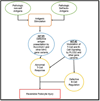Genetics of childhood steroid-sensitive nephrotic syndrome
- PMID: 27470160
- PMCID: PMC5276801
- DOI: 10.1007/s00467-016-3456-8
Genetics of childhood steroid-sensitive nephrotic syndrome
Abstract
The pathogenesis of childhood-onset nephrotic syndrome (NS), disparity in incidence of NS among races, and variable responses to therapies in children with NS have defied explanation to date. In the last 20 years over 50 genetic causes of steroid-resistant nephrotic syndrome (SRNS) have been identified, and at least two disease loci for two pathologic variants of SRNS (focal segmental glomerulosclerosis and membranous nephropathy) have been defined. However, the genetic causes and risk loci for steroid-sensitive nephrotic syndrome (SSNS) remain elusive, partly because SSNS is relatively rare and also because cases of SSNS vary widely in phenotypic expression over time. A recent study of a well-defined modest cohort of children with SSNS identified variants in HLA-DQA1 as a risk factor for SSNS. Here we review what is currently known about the genetics of SSNS and also discuss how recent careful phenotypic and genomic studies reinforce the role of adaptive immunity in the molecular mechanisms of SSNS.
Keywords: GWAS; Genetic risks; Genomics; Nephrotic syndrome children.
Figures
Similar articles
-
HLA-DQA1 and APOL1 as Risk Loci for Childhood-Onset Steroid-Sensitive and Steroid-Resistant Nephrotic Syndrome.Am J Kidney Dis. 2018 Mar;71(3):399-406. doi: 10.1053/j.ajkd.2017.10.013. Epub 2017 Dec 23. Am J Kidney Dis. 2018. PMID: 29277510 Free PMC article.
-
Association of HLA-DR/DQ alleles and haplotypes with nephrotic syndrome.Nephrology (Carlton). 2016 Sep;21(9):745-52. doi: 10.1111/nep.12669. Nephrology (Carlton). 2016. PMID: 26566811
-
HLA-DQA1 and PLCG2 Are Candidate Risk Loci for Childhood-Onset Steroid-Sensitive Nephrotic Syndrome.J Am Soc Nephrol. 2015 Jul;26(7):1701-10. doi: 10.1681/ASN.2014030247. Epub 2014 Oct 27. J Am Soc Nephrol. 2015. PMID: 25349203 Free PMC article.
-
Difficult-to-treat idiopathic nephrotic syndrome: established drugs, open questions and future options.Pediatr Nephrol. 2018 Oct;33(10):1641-1649. doi: 10.1007/s00467-017-3780-7. Epub 2017 Sep 6. Pediatr Nephrol. 2018. PMID: 28879428 Review.
-
Genetics of Childhood Steroid Sensitive Nephrotic Syndrome: An Update.Front Pediatr. 2019 Jan 29;7:8. doi: 10.3389/fped.2019.00008. eCollection 2019. Front Pediatr. 2019. PMID: 30761277 Free PMC article. Review.
Cited by
-
Novel insights in the genetics of steroid-sensitive nephrotic syndrome in childhood.Pediatr Nephrol. 2021 Aug;36(8):2165-2175. doi: 10.1007/s00467-020-04780-4. Epub 2020 Oct 21. Pediatr Nephrol. 2021. PMID: 33084934 Review.
-
Minimal change disease and idiopathic FSGS: manifestations of the same disease.Nat Rev Nephrol. 2016 Dec;12(12):768-776. doi: 10.1038/nrneph.2016.147. Epub 2016 Oct 17. Nat Rev Nephrol. 2016. PMID: 27748392 Review.
-
A genomic association study revealing subphenotypes of childhood steroid-sensitive nephrotic syndrome in a larger genomic sequencing cohort.Genes Dis. 2023 Sep 27;11(4):101126. doi: 10.1016/j.gendis.2023.101126. eCollection 2024 Jul. Genes Dis. 2023. PMID: 38560502 Free PMC article.
-
Low-dose rituximab is no less effective for nephrotic syndrome measured by 12-month outcome.Pediatr Nephrol. 2019 May;34(5):855-863. doi: 10.1007/s00467-018-4172-3. Epub 2018 Dec 18. Pediatr Nephrol. 2019. PMID: 30564878 Free PMC article.
-
B Lymphocyte Subsets in Children With Steroid-Sensitive Nephrotic Syndrome: A Longitudinal Study.Front Pediatr. 2021 Oct 8;9:736341. doi: 10.3389/fped.2021.736341. eCollection 2021. Front Pediatr. 2021. PMID: 34692611 Free PMC article.
References
-
- Eddy AA, Symons JM. Nephrotic syndrome in childhood. Lancet. 2003;362:629–639. - PubMed
-
- Primary nephrotic syndrome in children: clinical significance of histopathologic variants of minimal change and of diffuse mesangial hypercellularity. A Report of the International Study of Kidney Disease in Children. Kidney Int. 1981;20:765–771. - PubMed
-
- Lombel RM, Gipson DS, Hodson EM Kidney Disease: Improving Global O. Treatment of steroid-sensitive nephrotic syndrome: new guidelines from KDIGO. Pediatr Nephrol. 2013;28:415–426. - PubMed
-
- Shalhoub RJ. Pathogenesis of lipoid nephrosis: a disorder of T-cell function. Lancet. 1974;2:556–560. - PubMed
Publication types
MeSH terms
Substances
Grants and funding
LinkOut - more resources
Full Text Sources
Other Literature Sources
Medical
Research Materials
Miscellaneous


